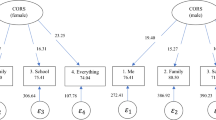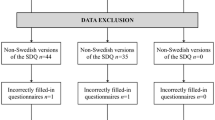Abstract
Background
Proper parent–child interaction is crucial for child development, but an assessment tool in Chinese is currently lacking. This study aimed to develop and validate a parent-reported parent–child interaction scale for Chinese preschool children.
Methods
The Chinese parent–child interaction scale (CPCIS) was designed by an expert panel based on the literature and clinical observations in the Chinese context. The initial CPCIS had 14 parent–child interactive activity items. Psychometric properties of the CPCIS were examined using the Rasch model and confirmatory factor analysis (CFA). Convergent validity was investigated by the associations between CPCIS and family income, maternal education level, and children’s school readiness.
Results
The study recruited 567 Chinese parent–child pairs from diverse socioeconomic backgrounds, who completed the CPCIS. Six out of the 14 items in the initial CPCIS were dropped due to suboptimal fit values. The refined 8-item CPCIS was shown to be valid and reliable by Rasch models and CFA. The person separation reliability and Cronbach’s α of the CPCIS were 0.81 and 0.82, respectively. The CPCIS scores were positively associated with family’s socioeconomic status (η2 = 0.05, P < 0.001), maternal education level (η2 = 0.08, P < 0.001), and children’s school readiness (η2 = 0.01, P < 0.01).
Conclusion
CPCIS is an easily administered, valid, and reliable tool for the assessment of parent–child interactions in Chinese families.



Similar content being viewed by others
References
Ronfani L, Brumatti LV, Mariuz M, Tognin V, Bin M, Ferluga V, et al. The complex interaction between home environment, socioeconomic status, maternal iq and early child neurocognitive development: a multivariate analysis of data collected in a newborn cohort study. PLoS ONE. 2015;10:e0127052.
Moss E, Rousseau D, Parent S, St-Laurent D, Saintonge J. Correlates of attachment at school age: maternal reported stress, mother-child interaction, and behavior problems. Child Dev. 1998;69:1390–405.
Nieuwesteeg AM, Pouwer F, van Bakel HJ, Emons WH, Aanstoot HJ, Odink R, et al. Quality of the parent-child interaction in young children with type 1 diabetes mellitus: study protocol. BMC Pediatr. 2011;11:28.
Biringen Z, Easterbrooks MA. Emotional availability: concept, research, and window on developmental psychopathology. Dev Psychopathol. 2012;24:1–8.
Jaeger E. Child care and mother-child interaction in the first 3 years of life. NICHD early child care research network. Dev Psychol. 1999;35:1399–413.
Nieuwesteeg A, Hartman E, Pouwer F, Emons W, Aanstoot HJ, Van Mil E, et al. Qualitative observation instrument to measure the quality of parent-child interactions in young children with type 1 diabetes mellitus. BMC Pediatr. 2014;14:145.
Robinson EA, Eyberg SM. The dyadic parent-child interaction coding system: standardization and validation. J Consult Clin Psychol. 1981;49:245–50.
Mendelsohn A, Dreyer B, Tamis-LeMonda C, Ahuja P. Validity of StimQ, a scale for assessing the cognitive home environment. J Dev Behav Pediatr. 1999;20:399.
Burston A, Puckering C, Kearney E. At HOME in Scotland: validation of the home observation for measurement of the environment inventory. Child Care Health Dev. 2005;31:533–8.
Lee WO. The cultural context for Chinese learners: conceptions of learning in the confucian tradition. In: Watkins DA, Biggs JB, editors. The Chinese learner: Cultural, psychological and contextual influences. Hong Kong: Comparative Education Research Centre and Australian Council of Educational Research; 1996. p. 63–7.
Totsika V, Sylva K. The home observation for measurement of the environment revisited. Child Adolesc Ment Health. 2004;9:25–35.
Rao N, Ng SS, Sun J. Early learning experiences of young Chinese learners in Hong Kong: the role of traditional values and changing educational policy. In: King RB, Bernardo ABI, editors. The psychology of asian learners. Dordrecht: Springer; 2016. p. 635–49.
Lau EYH, Li H, Rao N. Exploring parental involvement in early years education in China: development and validation of the Chinese early parental involvement scale (CEPIS). Int J Early Years Educ. 2012;20:405–21.
Hong Kong Census and Statistics Department. Population and household statistics analysed by district council district. Hong Kong: Census and Statistics Department; 2012.
Ip P, Li SL, Rao N, Ng SS, Lau WW, Chow CB. Validation study of the Chinese early development instrument (CEDI). BMC Pediatr. 2013;13:146.
Wright BD, Masters GN. Rating scale analysis. Chicago: Mesa Press; 1982.
Mair P, Hatzinger R. Extended Rasch modeling: the eRm package for the application of IRT models in R. J Stat Softw. 2007;20:1.
Tesio L. Measurement in clinical vs. biological medicine: the Rasch model as a bridge on a widening gap. J Appl Meas. 2004;5:362–6.
Wright BD, Linacre JM, Gustafson J, Martin-Lof P. Reasonable mean-square fit values. Rasch Meas Trans. 1994;8:370.
Mair P, Hatzinger R. CML based estimation of extended Rasch models with the eRm package in R. Psychol Sci. 2007;49:26.
Linacre JM. Unidimensional models in a multidimensional world. Rasch Meas Trans. 2009;23:1209.
Smith EV Jr. Understanding Rasch measurement: detecting and evaluating the impact of multidimensionality using item fit statistics and principal component analysis of residuals. J Appl Meas. 2002;3:205–31.
Smith RM, Miao CY. Assessing unidimensionality for Rasch measurement. In: Wilson M, editor. Objective measurement: theory into practice. Greenwich: Ablex; 1994.
Wright BD, Stone MH. Measurement essentials. Wilmington: Wide Range; 1999.
Hooper D, Coughlan J, Mullen MR. Structural equation modelling: guidelines for determining model fit. Electron J Bus Res Methods. 2008;6:53–60.
Kwok MK, Schooling CM, Lam TH, Leung GM. Does breastfeeding protect against childhood overweight? Hong Kong’s "Children of 1997" birth cohort. Int J Epidemiol. 2010;39:297–305.
Janus M, Offord DR. Development and psychometric properties of the early development instrument (EDI): a measure of children’s school readiness. Can J Behav Sci. 2007;39:1–22.
Cohen J. Statistical power analysis for the behavioral sciences Hillsdale. New Jersey: Lawrence Erlbaum Associates; 1988.
Aspland H, Gardner F. Observational measures of parent-child interaction: an introductory review. Child Adolesc Ment Health. 2003;8:136–43.
Lytton H. Observation studies of parent-child interaction: a methodological review. Child Dev. 1971;42:651–84.
Dodici BJ, Draper DC, Peterson CA. Early parent–child interactions and early literacy development. Top Early Child Spec. 2003;23:124–36.
Ginsburg KR. The importance of play in promoting healthy child development and maintaining strong parent–child bonds. Pediatrics. 2007;119:182–91.
Mathews A, Bradle B. Mood and the self-reference bias in recall. Behav Res Ther. 1983;21:233–9.
Brunner E, Juneja M, Marmot M. Dietary assessment in Whitehall II: comparison of 7 days diet diary and food-frequency questionnaire and validity against biomarkers. Br J Nutr. 2001;86:405–14.
Dodge KA, Pettit GS, Bates JE. Socialization mediators of the relation between socioeconomic status and child conduct problems. Child Dev. 1994;65:649–65.
Davis-Kean PE. The influence of parent education and family income on child achievement: the indirect role of parental expectations and the home environment. J Fam Psychol. 2005;19:294.
O’Brien M. Shared caring: bringing fathers into the frame. Manchester: Equal Opportunities Commission; 2005.
Gornick JC, Heron A. The regulation of working time as work-family reconciliation policy: comparing Europe, Japan, and the United States. J Comp Policy Analysis. 2006;8:149–66.
Booth CL, Clarke-Stewart KA, Vandell DL, McCartney K, Owen MT. Child care usage and mother-infant “quality time”. J Marriage Fam. 2002;64:16–26.
Funding
The study was fully supported by a grant from the Research Grants Council of the Hong Kong Special Administrative Region, China (Project No. 743413 and 746111). The funding body has no responsibilities in study design, the collection, analysis, and interpretation of data, the writing of the report, and the decision to submit the manuscript.
Author information
Authors and Affiliations
Contributions
Dr. Ip conceptualized and designed the study, interpreted the data, and critically revised the manuscript. Dr. Tso interpreted the data and drafted the manuscript. Prof. Rao contributed to study design, interpreted the data, and critically revised the manuscript. Mr. Ho analyzed the data and drafted the manuscript. Drs. Chan, Fu, Li, and Goh interpreted the data and critically revised the manuscript. Mr. Wong and Dr. Chow assisted study design, interpreted the data, and critically revised the manuscript. All authors approved the final manuscript as submitted.
Corresponding author
Ethics declarations
Ethical approval
The study was approved by the ethical committee of the Institutional Review Board of the University of Hong Kong. Informed written consent was obtained from the parents of each participant. Study procedure was carried out in accordance with the approved guidelines.
Conflict of interest
No financial or non-financial benefits have been received or will be received from any party related directly or indirectly to the subject of this article.
Electronic supplementary material
Below is the link to the electronic supplementary material.
Rights and permissions
About this article
Cite this article
Ip, P., Tso, W., Rao, N. et al. Rasch validation of the Chinese parent–child interaction scale (CPCIS). World J Pediatr 14, 238–246 (2018). https://doi.org/10.1007/s12519-018-0132-z
Received:
Revised:
Accepted:
Published:
Issue Date:
DOI: https://doi.org/10.1007/s12519-018-0132-z




